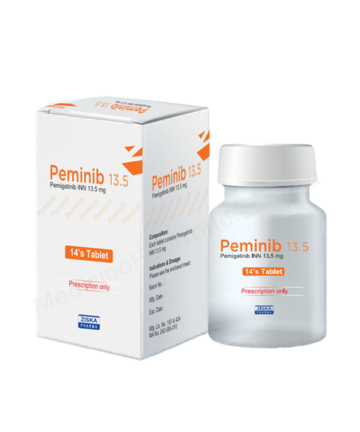Don't miss our holiday offer - up to 50% OFF!
Peminib 13.5 mg Pemigatinib INN

Composition
Peminib 13.5 Tablet: Each tablet contains Pemigatinib INN 13.5 mg.
Pharmacology
Pemigatinib is a small molecule kinase inhibitor that targets FGFR1, 2 and 3 with IC50 values of less
than 2 nM. Pemigatinib also inhibited FGFR4 in vitro at a concentration approximately 100 times higher
than those that inhibit FGFR1, 2, and 3. Pemigatinib inhibited FGFR1-3 phosphorylation and signaling
and decreased cell viability in cancer cell lines with activating FGFR amplifications and fusions that
resulted in constitutive activation of FGFR signaling. Constitutive FGFR signaling can support the
proliferation and survival of malignant cells. Pemigatinib exhibited anti-tumor activity in mouse
xenograft models of human tumors with FGFR1, FGFR2, or FGFR3 alterations resulting in constitutive
FGFR activation including a patient-derived xenograft model of cholangiocarcinoma that expressed an
oncogenic FGFR2- Transformer-2 beta homolog (TRA2b) fusion protein.
Indications
Pemigatinib is indicated for the treatment of adults with previously treated, unrespectable locally
advanced or metastatic cholangiocarcinoma with a fibroblast growth factor receptor 2 (FGFR2) fusion
or other rearrangement as detected by an FDA-approved test.
This indication is approved under accelerated approval based on overall response rate and duration of
response. Continued approval for this indication may be contingent upon verification and description of
clinical benefit in a confirmatory trial(s).
Dosage and Administration
The recommended dosage of Pemigatinib is 13.5 mg orally once daily for 14 consecutive days followed
by 7 days off therapy, in 21-day cycles. Continue treatment until disease progression or unacceptable
toxicity occurs.
Take Pemigatinib with or without food at approximately the same time every day.
Swallow tablets whole. Do not crush, chew, split or dissolve tablets.
If the patient misses a dose of Pemigatinib by 4 or more hours or if vomiting occurs, resume dosing with
the next scheduled dose.
Adverse Reactions
- Ocular Toxicity
- Hyperphosphatemia and Soft Tissue Mineralization
Warnings and Precautions
Retinal Pigment Epithelial Detachment (RPED)
Pemigatinib can cause RPED, which may cause symptoms such as blurred vision, visual floaters, or
photopsia. Clinical trials of Pemigatinib did not conduct routine monitoring including optical coherence
tomography (OCT) to detect asymptomatic RPED; therefore, the incidence of asymptomatic RPED
with Pemigatinib is unknown.
Dry Eye - Among 466 patients who received Pemigatinib across clinical trials, dry eye occurred in 27% of
- patients, including Grade 3-4 in 0.6% of patients. Treat patients with ocular demulcents as needed.
- Hyperphosphatemia and Soft Tissue Mineralization
- Pemigatinib can cause hyperphosphatemia leading to soft tissue mineralization, cutaneous
- calcification, calcinosis, and non-uremic calciphylaxis. Increases in phosphate levels are a
- pharmacodynamics effect of Pemigatinib. Among 466 patients who received Pemigatinib across
- clinical trials, hyperphosphatemia was reported in 92% of patients based on laboratory values above
- the upper limit of normal. The median time to onset of hyperphosphatemia was 8 days (range 1-169).
- Phosphate lowering therapy was required in 29% of patients receiving Pemigatinib.
- Contraindications
- None.
- Use in Specific Populations
- Pregnancy
- Based on findings in an animal study and its mechanism of action, Pemigatinib can cause fetal harm
- or loss of pregnancy when administered to a pregnant woman. There are no available data on the use
- of Pemigatinib in pregnant women. Oral administration of Pemigatinib to pregnant rats during the
- period of organogenesis at maternal plasma exposures below the human exposure at the clinical dose
- of 13.5 mg resulted in fetal malformations, fetal growth retardation, and embryo-fetal death. Advise
- pregnant women of the potential risk to a fetus.
- Lactation
- There are no data on the presence of pemigatinib or its metabolites in human milk or their effects on
- either the breastfed child or on milk production. Because of the potential for serious adverse reactions
- in breastfed children from Pemigatinib, advise women not to breastfeed during treatment and for 1
- week after the final dose.
- Females and Males of Reproductive Potential
- Verify pregnancy status of females of reproductive potential prior to initiating Pemigatinib.
- Pediatric Use
- The safety and effectiveness of Pemigatinib have not been established in pediatric patients.
- Storage
- Do not store above 25ºC. Protect from light. Keep out of reach of children.
- Packaging
- Peminib 13.5 Tablet: Each HDPE container of Peminib 13.5 contains 14’s tablet, a silica gel desiccant
- and polyester coil with a child resistant closure.

